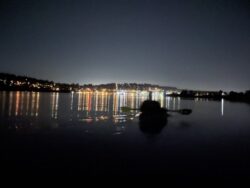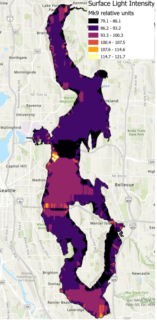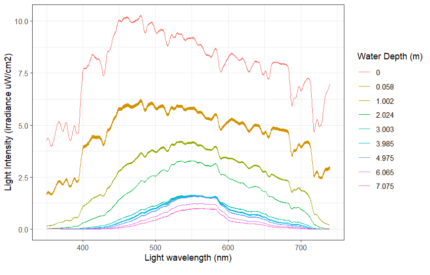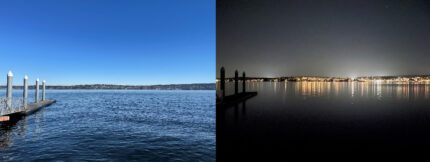by Tessa Code, Master’s student, University of Washington School of Aquatic and Fisheries Sciences

Mapping the light level of Lake Washington at night. Data was collected after astronomical twilight under moonless, cloudless skies.
In aquatic ecosystems, daily light fluctuations signal refuging or foraging periods and seasonal changes in light cycles serve as cues for migration and reproduction. Artificial light at night (ALAN) is disrupting natural light cycles by extending twilight periods, increasing nocturnal light levels, and blurring indicators of seasonal change. ALAN threatens juvenile salmon survival – to an extent that has not been addressed — by enhancing the foraging conditions of their predators.
Salmon are known to be sensitive to the disruption of natural light cycles, with artificial lights disrupting salmon migration and attracting juvenile salmon in nearshore environments where they are vulnerable to visual predation. Sockeye salmon (Oncorhynchus nerka) spend an extended period in lakes (12-15 months), primarily residing in the offshore environment, and feeding at shallower depths during low-light periods. This species is particularly at risk in urbanized watersheds because ALAN increases light throughout the water column, leaving juvenile sockeye at higher risk of predation.

Figure 1: Preliminary results of relative light surface light level in Lake Washington. Values are reported on a log scale and measure the blue light spectra. Parallel cross-lake transects were conducted at 1-km spacing while all shorelines were measured. Values were calibrated to eliminate tag-to-tag variability and transect measurements were interpolated.
Salmon predators are primarily visual foragers whose foraging ability improves quadratically with even slight increases in light. Visual predators typically have an advantage over their prey in low-light conditions like dawn or dusk. In waters with just natural light, the fish predators only have this advantage during twilight periods, which limits their access to prey populations. ALAN extends the time these low-light conditions exist and increases the time in which salmon predators have the upper hand. Even slight increases in predation and mortality can affect the survivorship of individual salmon cohorts and the population level. My research, funded in part by WALPA’s Dave Lamb Memorial Scholarship, aims to quantify how artificial light is influencing the predation of juvenile salmon in Lake Washington.
Lake Washington is a highly urbanized lake with a resident population of sockeye experiencing dwindling numbers despite a 17-year harvest moratorium. Lake Washington is rimmed with extensive residential neighborhoods, major industrial complexes, and three rapidly expanding cities. In the last 20 years, the population of the major cities bordering Lake Washington has drastically increased: Seattle by 31%, Bellevue by 39%, Kirkland by 104%, Mercer Island by 17%, and Renton by 114% (census.gov). During this time, local cities have replaced high-pressure sodium bulb streetlighting with substantially brighter light emitting diodes (LEDs). Despite recognition that artificial light has negative impacts on salmon, the light levels in Lake Washington have never been systematically measured.
Initial project findings show that there is a variable lightscape in Lake Washington (Figure 1). Surface light was collected by a small but highly sensitive light sensor (Wildlife Computers, TDR-Mk9) that measures relative light intensity in the blue light spectra (415-460 nm). Light sensors were mounted on kayaks and small boats to measure light along the shorelines and in the offshore environment. This effort was the first step in determining the ambient light levels juvenile salmon experience in the watershed.

Figure 2: Light attenuation across many bandwidths of light. Colored lines distinguish sample depths, with the top (red) line as the surface measurement. As depth increases, light wavelengths extinguish at different rates. At the deepest measured depths, light with wavelength between 500-600nm (light blue to green) decreases in strength at the slowest rate.
I am working to expand our analysis to include a wider bandwidth of light colors to match the visual sensitivity of salmon and extend our data collection below the surface. Commercially available lighting types have unique color composition that changes the depth that light can travel through water. I measure the rate of light attenuation by season in Lake Washington (Figure 2). Light attenuation, the rate at which light decreases in intensity, changes with water clarity and other properties. If water conditions change drastically, the rate of light extinction through the water column will change as well. Over the past few months, I collected light attenuation data through the seasonal phytoplankton bloom. I plan to continue sampling through peak summer stratification and the fall season as well. Analyzing this information will help us understand how the light environment changes for juvenile salmon through the growing season.

Looking east from the Magnuson Park boat launch towards Kirkland at noon and at night (two hours after sunset).
Light measurements will be integrated into a visual foraging model to estimate how the effectiveness of a native salmon predator (cutthroat trout, O. clarkii) changes throughout the lightscape of Lake Washington. Cutthroat trout are the main offshore predator of juvenile salmon and have been a focus of recent visual foraging studies. Using in situ light measurements, seasonal turbidity values, and previously measured swimming speeds of cutthroat in Lake Washington, I will assess how the predator search volume changes with respect to light intensity and season. Paired with prey fish depth and abundance data, collected using hydro-acoustics, I will overlay seasonal prey fish distribution to further interpret model results. This will illustrate how the relative predation risk to juvenile sockeye changes through time and space. This research will help highlight conditions that affect survivorship of juvenile salmon in Lake Washington and help define light level goals for the WRIA 8 (Lake Washington/Cedar/Sammamish) watershed in the ongoing work to recover salmon populations.









